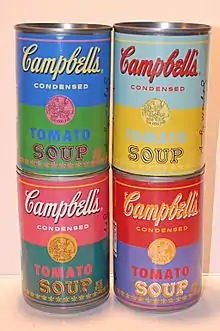Commercial art
Commercial art is the art of creative services, referring to art created for commercial purposes, primarily advertising. Commercial art uses a variety of platforms (magazines, websites, apps, television, etc.) for viewers with the intent of promoting the sale and interest of products, services, and ideas.[1] It relies on the iconic image (pictorial representations that are recognized easily to members of a culture) to enhance recall and favorable recognition for a product or service.[2] An example of a product could be a magazine ad promoting a new soda through complementary colors, a catchy message, and appealing illustrative features.[3] Another example could be promoting the prevention of global warming by encouraging people to walk or ride a bike instead of driving in an eye catching poster. It communicates something specific to an audience.

People can obtain training, certifications, and degrees that incorporate commercial arts in many exercises, activities, and programs.
Skills
Commercial artists have the ability to organize information and knowledge of fine arts, visualization and media in a way to reach an audience's attention. Some of these skills may include the following:[1][3]
- Attention to detail
- Ability to communicate effectively
- Experience or skills in the fine arts (drawing, painting, photography, etc.)
- Knowledgeable of certain computer software programs (graphics, editing, etc.) and ability to use them
- Marketing skills
- Advertising skills
- Coordination skills
- Animation skills
Genres
Commercial art can include many genres of art and categories of art technique, including:[4]
- Commercial character design
- Illustration
- Graphic design
- Industrial design
 Andy Warhol, Campbell Soup
Andy Warhol, Campbell Soup - Motion graphic design
- Photography
- Television commercials
- Music videos
- Animation
- Computer art
- Fashion designer
- Store art
- Decorative
- Ornamental
Consumerism within commercial art
Commercial art is art that is created for commercial purposes to promote services or products to viewers.[1] In the process of creating commercial art, an audience is taken into consideration when designing and/or forming the goods that are being advertised/promoted. An example of this can be seen in the recognized works of American painter and consumer ad designer, Andy Warhol.[5] Using Campbell's soup and Coca-Cola bottles as everyday products of consumers, he recreated a visually stimulating design through pop art that advertises the products through consumption habits of consumers.[5] Consumerism was present when pop art was popular. Pop art could contain mass cultural objects and/or celebrities (popular culture and mass media) to endorse markets and goods.[6]
References
- "What is Commercial Art?". Retrieved 19 August 2016.
- C., Woodward, Gary (2014). Persuasion and influence in American life. Denton, Robert E., Jr. (Seventh ed.). Long Grove, Illinois. ISBN 9781478607892. OCLC 879527515.
{{cite book}}: CS1 maint: location missing publisher (link) CS1 maint: multiple names: authors list (link) - "Commercial Artist: Job Description & Career Information". Study.com. Retrieved 2018-04-04.
- "11 Types Of Commercial Art". Simplicable. Retrieved 2018-04-25.
- "Andy Warhol Biography, Art, and Analysis of Works". The Art Story. Retrieved 2018-04-11.
- "Pop Art Movement, Artists and Major Works". The Art Story. Retrieved 2018-04-28.